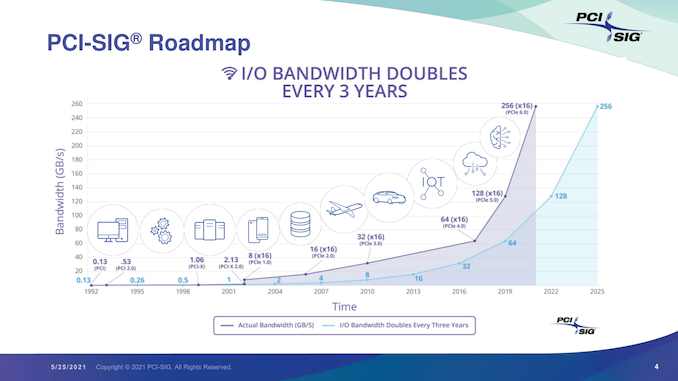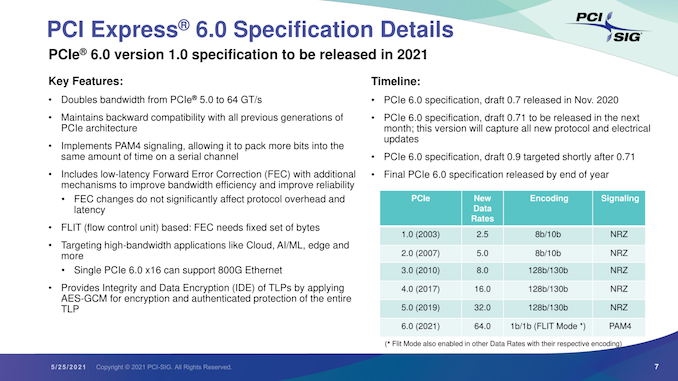Update: PCI Express 6.0 Draft 0.71 Released, Final Release by End of Year
by Ryan Smith on July 2, 2021 7:00 AM EST- Posted in
- CPUs
- Interconnect
- PCIe
- PCI-SIG
- PCIe 6.0

Update 07/02: Albeit a couple of days later than expected, the PCI-SIG has announced this morning that the PCI Express draft 0.71 specification has been released for member review. Following a minimum 30 day review process, the group will be able to publish the draft 0.9 version of the specficiation, putting them on schedule to release the final version of the spec this year.
Originally Published 05/25
As part of their yearly developer conference, the PCI Special Interest Group (PCI-SIG) also held their annual press briefing today, offering an update on the state of the organization and its standards. The star of the show, of course, was PCI Express 6.0, the upcoming update to the bus standard that will once again double its data transfer rate. PCI-SIG has been working on PCIe 6.0 for a couple of years now, and in a brief update, confirmed that the group remains on track to release the final version of the specification by the end of this year.
The most recent draft version of the specification, 0.7, was released back in November. Since then, PCI-SIG has remained at work collecting feedback from its members, and is gearing up to release another draft update next month. That draft will incorporate the all of the new protocol and electrical updates that have been approved for the spec since 0.7.
In a bit of a departure from the usual workflow for the group, however, this upcoming draft will be 0.71, meaning that PCIe 6.0 will be remaining at draft 0.7x status for a little while longer. The substance of this decision being that the group is essentially going to hold for another round of review and testing before finally clearing the spec to move on to the next major draft. Overall, the group’s rules call for a 30-day review period for the 0.71 draft, after which the group will be able to release the final draft 0.9 specification.
Ultimately, all of this is to say that PCIe 6.0 remains on track for its previously-scheduled 2021 release. After draft 0.9 lands, there will be a further two-month review for any final issues (primarily legal), and, assuming the standard clears that check, PCI-SIG will be able to issue the final, 1.0 version of the PCIe 6.0 specification.
In the interim, the 0.9 specification is likely to be the most interesting from a technical perspective. Once the updated electrical and protocol specs are approved, the group will be able to give some clearer guidance on the signal integrity requirements for PCIe 6.0. All told we’re not expecting much different from 5.0 (in other words, only a slot or two on most consumer motherboards), but as each successive generation ratchets up the signaling rate, the signal integrity requirements have tightened.
Overall, the unabashedly nerdy standards group is excited about the 6.0 standard, comparing it in significance to the big jump from PCIe 2.0 to PCIe 3.0. Besides proving that they’re once again able to double the bandwidth of the ubiquitous bus, it will mean that they’ve been able to keep to their goal of a three-year cadence. Meanwhile, as the PCIe 6.0 specification reaches completion, we should finally begin seeing the first PCIe 5.0 devices show up in the enterprise market.












103 Comments
View All Comments
fallaha56 - Wednesday, May 26, 2021 - link
https://www.pugetsystems.com/labs/articles/PCI-Exp...mode_13h - Wednesday, May 26, 2021 - link
Thank you.Wow, the difference in DaVinci Resolve is huge!
mode_13h - Wednesday, May 26, 2021 - link
> Even a RTX 3090 isn't limited by pcie 3.0x16.That's not true, but you won't find a *huge* performance difference between 3.0 and 4.0, either.
> For consumers the network limit is the internet connection.
Did you ever imagine that people might use their network connection to copy data between PCs on their LAN? Have you ever heard of a NAS or a file server?
> Just look at 10gbe.
2.5 Gbps seems to be the new enthusiast standard. Not as high as I wish, but it's progress.
ICT Buff - Friday, May 28, 2021 - link
"For consumers the network limit is the internet connection." That's a joke, right?dotjaz - Tuesday, June 1, 2021 - link
We still don't have any consumer product exceeding the need of PCIe 4.0 x8mode_13h - Wednesday, June 2, 2021 - link
That's not strictly true. As linked by @fallaha56, high-end gaming cards show some additional gaming performance from PCIe 4.0 x16 vs. 3.0 x16 (which is roughly equivalent to 4.0 x8).FLORIDAMAN85 - Saturday, July 10, 2021 - link
Lololol 😆fallaha56 - Wednesday, May 26, 2021 - link
Sure Digital, after all 640kb should be enough for everybody ;))Given moves in eg VR and AI in gaming and visualisations surely it would seem for years to come we will need more bandwidth
mode_13h - Wednesday, May 26, 2021 - link
> it would seem for years to come we will need more bandwidthEven with the benchmarks you just posted, I think gaming cards will stay at PCIe 4.0 for the foreseeable future.
Compute accelerators are likely to just go for CXL, though I think some might support both, for at least a while. CXL should be lower-latency and has coherency support built-in.
mode_13h - Wednesday, May 26, 2021 - link
> Even with the benchmarks you just posted, I think gaming cards will stay at PCIe 4.0In fact, precisely *because* your benchmarks show such a small impact on gaming, from stepping up to 4.0.